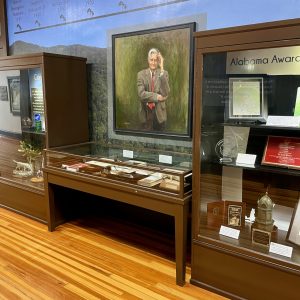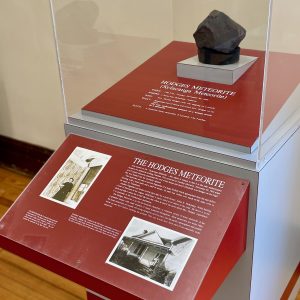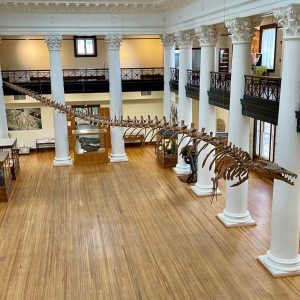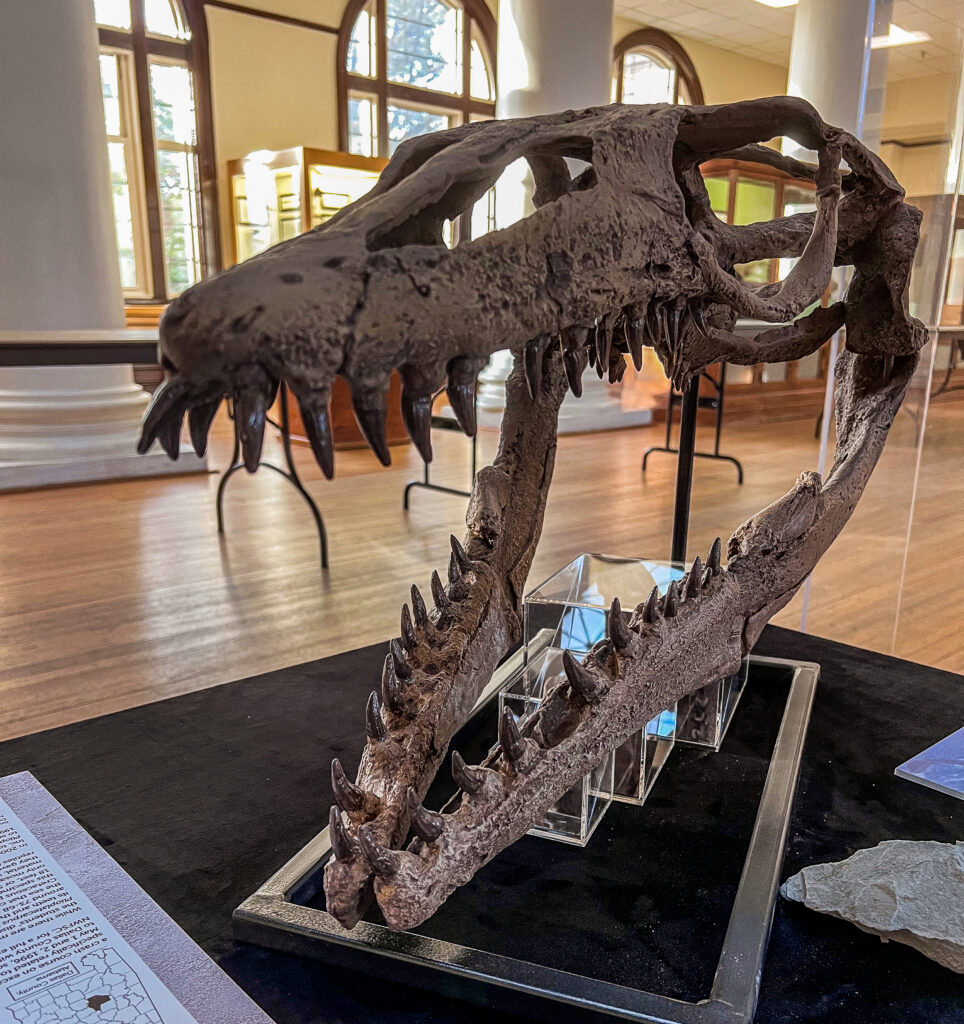Explore Alabama’s rich natural history with the Alabama Museum of Natural History. See exhibits that tell a story dating back 500 million years to the first fossils found in the state. Discover the ancient life, archaeological past, and natural beauty of Alabama.

Dr. Edward O. Wilson Awards (First Floor)
This UA student-designed and built exhibit features a selection of awards given to Dr. Edward O. Wilson, an American biologist, naturalist, writer, and UA alumnus. Through the course of his career, he has also received more than 150 prestigious awards and medals around the world and has generously donated them to the University of Alabama.
Discovering Alabama (First Floor)
This exhibit is all about the longest-running and most popular locally produced show on Alabama Public Television that started back in 1985 when Dr. Doug Phillips first invited viewers to “Come along with me as we explore the wild wonders of this land.”

Dr. Smith’s Wagon (Grand Gallery)
Dr. Eugene Allen Smith (1841-1927) was a professor, geologist, and naturalist who traveled by mule-drawn wagon throughout Alabama after the Civil War to find natural resources that could be used to develop industry in the state. His efforts in working with the state legislature also resulted in permanent funding for the Geological Survey of Alabama and a building, now the Alabama Museum of Natural History, on the University of Alabama campus designed by Smith to house his collections and the collections donated by others, as well as classrooms and laboratories for students.
Coal Age Alabama (Grand Gallery)
The exhibit with the oldest fossils on display is the coal age exhibit, easily spotted by a giant mural of a swamp on the wall. The display case contains plant fossils and footprints from the Pennsylvanian epoch (~320 million years old) of northern Alabama. Outside the museum, three tree stumps from the same time can be seen: one on the east side of Smith Hall in the parking lot and two at the west entrance.

Hodges Meteorite (Grand Gallery)
The Sylacauga meteorite fell on November 30, 1954, in Oak Grove, Alabama, near Sylacauga. It is commonly called the Hodges meteorite because a fragment of it struck Ann Elizabeth Fowler Hodges (1920–1972). The grapefruit-sized fragment crashed through the roof of a farmhouse, bounced off a large wooden console radio, and hit Hodges while she napped on a couch.[3] The 34-year-old woman was badly bruised on one side of her body but was able to walk. The event received worldwide publicity.
Cretaceous Monsters of Alabama (Grand Gallery)
Most of the cabinets and display cases highlight impressive vertebrates that lived during the late part of the Cretaceous period, from ~85 to 66 million years ago when nearly all of Alabama was below sea level. These fossils include the giant predatory fish Xiphactinus audax, several marine turtle remains, and ancient marine reptiles that were the top predators in the Late Cretaceous oceans called mosasaurs. One of the most complete skeletons of mosasaurs in the world, nicknamed Artemis, is a true gem of the museum. Not only animals living in the ocean are displayed, but also dinosaurs such as a skull of the famous Tyrannosaurus rex and multiple bones of Cretaceous dinosaurs found in Alabama. Visitors can also check out some Jurassic dinosaur remains from out of state.

Ancient Whale – Alabama’s State Fossil (Grand Gallery)
Perhaps the most impressive specimen in the museum is a 60 ft (18 m) skeleton of an ancient toothed whale called Basilosaurus cetoides. This species serves as the state fossil of Alabama since 1984. Hanging from the ceiling, it gives visitors a dramatic view of the enormous size of this top predator living in the ocean in what is now southern Alabama during the late part of the Eocene epoch (~35 million years ago). In addition, a skull, bones, and teeth from this species are displayed in a separate cabinet.
Rocks and Minerals From Around The World (Grand Gallery)
Our Earthly lives are literally built on rocks and minerals. They compose the bedrock beneath our feet and form the foundation of modern life, providing the raw materials for the production of a host of goods, from aluminum cans to fireworks. People through the ages have cherished, collected, and adorned themselves with rocks and minerals and these natural treasures are no less revered by society today. The rocks and minerals displayed in the Geology Rocks! Exhibit have been collected from across the globe, including many in our own state of Alabama.
Ice Age Alabama (Grand Gallery)

Several cabinets contain vertebrate animals that were roaming Alabama during the Pleistocene epoch (2.5 million years ago to 11,700 years ago). This time was characterized by many very cold periods popularly called ice ages. Fossils of ground sloth, tapir, bison, deer, and other animals are on display. A visit to the Alabama Museum of Natural History would not be complete without an exhibit about the ancient relatives of our football mascot Big Al. Check out the mastodon and mammoth skulls as well as their large teeth.
Other exhibits include a comparison of fossil and modern representatives of various organisms and introductory panels with basic information about paleontology. Outside the museum near the south entrance, a petrified log from the Cretaceous period of Tuscaloosa county can be seen.
Freshwater Mussel Exhibit (Mezzanine)
The Freshwater Mussel Exhibit on the third floor explores Alabama’s Freshwater Biodiversity with a look into why they are important to our environment and mussel biology including learning how to age mussels. We also explore how mussels were used in fashion with a collaboration with The Fashion Archive at the University of Alabama, exploring how the fashion industry affected the mussel populations in Alabama. If this sparks your interest, we also have an online exhibit where you can learn more about all aspects of the exhibit.

Buzz about Bees (Mezzanine)
A collaborative exhibit with the Alabama Museum of Natural History, the West Alabama Beekeepers Association, and the UA Bee Club. The exhibit focuses on the honey bee and features a live beehive that gives visitors an inside look at the honey bees’ honey production and social structure. Although modern honey bees are an introduced species, there are over 4,000 species of bee native to North America, and while the honey bee is a tiny insect, it has an immeasurable impact.
Safford Mosasaur Exhibit (Grand Gallery)

The University of Alabama Museums’ paleontology collection contains over 1,000 mosasaur records, making it one of the largest mosasaur collections in the world! In Fall 2023, the Alabama Museum of Natural History collaborated with Dr. Adiel Klompmaker on an exhibit featuring the Safford Mosasaur, which was found in Dallas County, Alabama in 1996 by a group of college students from Northwest Florida State College. The skull in our exhibit is a complete reconstruction of the one that was found almost 30 years ago. In addition to the reconstructed skull, we have included some fragments of the original skull. While there are many different genera of mosasaurs, the students’ discovery was recognized as a Plioplatecarpus based on several features such as its teeth and the shape of its skull. This genus lived around 73-68 million years ago and swam through the sea that covered Alabama during the late Cretaceous period.